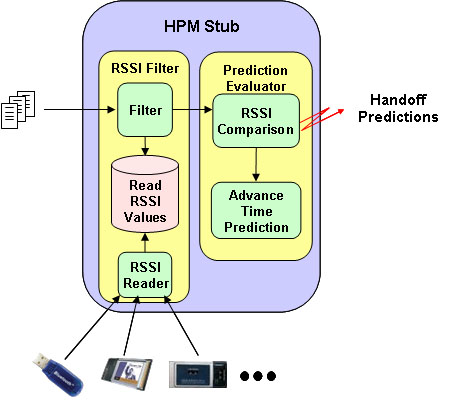MUM Components
|
MUM Components |
|
MUM Session Proxy/Client Stub Facilities
Handoff Prediction Monitor (HPM) MUM implements handoff prediction based on data-link monitoring information: it only requires accessing Received Signal Strength Indication values for all WI APs in client visibility and abstracts them to grant interoperability for the widest range of wireless technologies. HPM consists of two parts, deployed at client stub and session proxy, mainly interacting via events. The client-side part (see the following figure) periodically gathers RSSI data, calculates horizontal and vertical handoff predictions with our lightweight RSSI-Grey Model (RSSI-GM) predictor, and pushes prediction events to session proxy. The proxy-side part receives prediction events and notifies them to SCM to trigger MUM handoff decision and execution. | ||
 Client-side HPM |
||
|
Service Continuity Manager (SCM) SCM controls the overall handoff process: it subscribes itself to HPM to receive predictions of potential handoffs, decides and executes MUM handoff solutions, and triggers the actions of FSR. SCM can dynamically decide between two different handoff solutions, soft and hard, according both to service requirements and to handoff context information:
SCM executes both at client stub and session proxy. The client-side part accepts Service Level Specification (SLS) for service requirements (especially, tolerable delay, jitter, and data losses) and coordinates with session proxy for multimedia data delivery and for client-side buffer management. The proxy-side part decides and starts MUM management operations, controls data flow transmission over the last wired-wireless hop, and books/releases service gateway memory resources necessary to store proxy buffer. |
||
SCM | ||
Fast Service Re-binder (FSR) FSR provides fast component re-bind and client re-addressing, by re-establishing ongoing connections for control and multimedia data flows, disrupted by macro handoff; in case of global handoffs, it also supports session proxy migration/activation and context transfer towards the target WI domain. MUM exploits SIP basic mechanism for component re-binding. In particular, session proxies and client stub incarnate SIP entities, respectively Back to Back User Agents (B2BUAs) and User Agent Client (UAC), and interact by exchanging SIP messages. Moreover, to enable context transfer between old and target localities, we employ our original “ContextAwareness” SIP notification package [SIUMI06]. For any MUM facility running at both client and proxy sides, MUM maintains a MUM binding, inspired to the simple and effective binding interface proposed by [A/VCORBA]. MUM binding is replicated at both client stub and proxy node and maintains a list of all endpoints used for communication, UDP and TCP ports, wireless technology type, and IP address actually used. |
||
FSR |
||
MUM Service Gateway Facilities
More details will be available soon...
|
||
| 2-feb-10 |